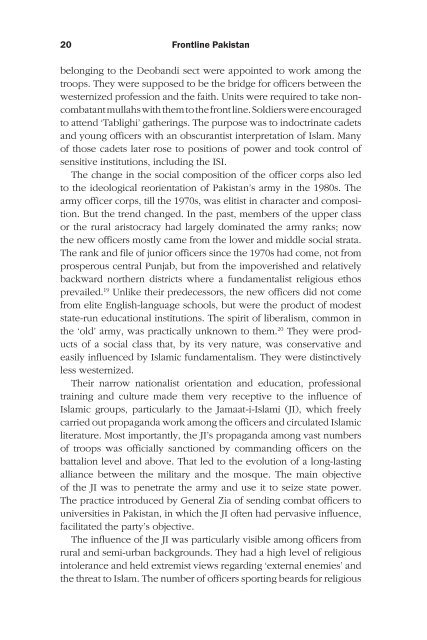Frontline Pakistan : The Struggle With Militant Islam - Arz-e-Pak
Frontline Pakistan : The Struggle With Militant Islam - Arz-e-Pak
Frontline Pakistan : The Struggle With Militant Islam - Arz-e-Pak
You also want an ePaper? Increase the reach of your titles
YUMPU automatically turns print PDFs into web optimized ePapers that Google loves.
0 <strong>Frontline</strong> <strong><strong>Pak</strong>istan</strong><br />
belonging to the Deobandi sect were appointed to work among the<br />
troops. <strong>The</strong>y were supposed to be the bridge for officers between the<br />
westernized profession and the faith. Units were required to take noncombatant<br />
mullahs with them to the front line. Soldiers were encouraged<br />
to attend ‘Tablighi’ gatherings. <strong>The</strong> purpose was to indoctrinate cadets<br />
and young officers with an obscurantist interpretation of <strong>Islam</strong>. Many<br />
of those cadets later rose to positions of power and took control of<br />
sensitive institutions, including the ISI.<br />
<strong>The</strong> change in the social composition of the officer corps also led<br />
to the ideological reorientation of <strong><strong>Pak</strong>istan</strong>’s army in the 1980s. <strong>The</strong><br />
army officer corps, till the 1970s, was elitist in character and composition.<br />
But the trend changed. In the past, members of the upper class<br />
or the rural aristocracy had largely dominated the army ranks; now<br />
the new officers mostly came from the lower and middle social strata.<br />
<strong>The</strong> rank and file of junior officers since the 1970s had come, not from<br />
prosperous central Punjab, but from the impoverished and relatively<br />
backward northern districts where a fundamentalist religious ethos<br />
prevailed. 19 Unlike their predecessors, the new officers did not come<br />
from elite English-language schools, but were the product of modest<br />
state-run educational institutions. <strong>The</strong> spirit of liberalism, common in<br />
the ‘old’ army, was practically unknown to them. 20 <strong>The</strong>y were products<br />
of a social class that, by its very nature, was conservative and<br />
easily influenced by <strong>Islam</strong>ic fundamentalism. <strong>The</strong>y were distinctively<br />
less westernized.<br />
<strong>The</strong>ir narrow nationalist orientation and education, professional<br />
training and culture made them very receptive to the influence of<br />
<strong>Islam</strong>ic groups, particularly to the Jamaat-i-<strong>Islam</strong>i (JI), which freely<br />
carried out propaganda work among the officers and circulated <strong>Islam</strong>ic<br />
literature. Most importantly, the JI’s propaganda among vast numbers<br />
of troops was officially sanctioned by commanding officers on the<br />
battalion level and above. That led to the evolution of a long-lasting<br />
alliance between the military and the mosque. <strong>The</strong> main objective<br />
of the JI was to penetrate the army and use it to seize state power.<br />
<strong>The</strong> practice introduced by General Zia of sending combat officers to<br />
universities in <strong><strong>Pak</strong>istan</strong>, in which the JI often had pervasive influence,<br />
facilitated the party’s objective.<br />
<strong>The</strong> influence of the JI was particularly visible among officers from<br />
rural and semi-urban backgrounds. <strong>The</strong>y had a high level of religious<br />
intolerance and held extremist views regarding ‘external enemies’ and<br />
the threat to <strong>Islam</strong>. <strong>The</strong> number of officers sporting beards for religious













